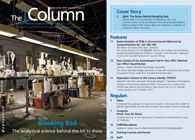Lung Tissue Fingerprinting
Scientists from San Pablo CEU University (Madrid, Spain) have developed a non-targeted global fingerprinting approach for lung tissue samples by performing three analytical methods ? liquid chromatography coupled to mass spectrometry (LC–MS), gas chromatography coupled to MS (GC?MS), and capillary electrophoresis coupled to MS (CE–MS). Published in the journal Analytical Chemistry, the study details the development and validation of the multi-platform approach using 20 mg of lung tissue.1
Scientists from San Pablo CEU University (Madrid, Spain) have developed a non-targeted global fingerprinting approach for lung tissue samples by performing three analytical methods — liquid chromatography coupled to mass spectrometry (LC–MS), gas chromatography coupled to MS (GC–MS), and capillary electrophoresis coupled to MS (CE–MS). Published in the journal Analytical Chemistry, the study details the development and validation of the multi-platform approach using 20 mg of lung tissue.1
Metabolomics is a growing area of research in biomedical science and can provide a fingerprint demonstrating the influence of genetic and environmental factors on underlying processes that keep the human body running. Coral Barbas, corresponding author of the paper, told The Column: “The analytical challenge in metabolomics is quite different to classical target analysis. In this case, an additional challenge was getting a single tissue homogenate and a single-phase extraction with a minimum sample amount as to make it feasible to small animal studies or human biopsies.”
LC–MS, GC–MS, and CE–MS are fast becoming the most used and most effective techniques in the field of metabolomics. However, there is still a need to reduce the volume of sample required, as well as give a more detailed picture of the metabolome of lung tissue. Barbas said: ”Tissue metabolomics has a great importance in biomedical research as it can provide different and sometimes more relevant information than bio-fluids. Although being invasive, tissue metabolomics has many advantages: The metabolomics modifications and the upstream regulations are first seen in tissue. Moreover, the pairwise comparisons of tissue taken from affected and non-affected regions may reflect the interactions, despite any individual differences. On the other hand, there are very few methods available for lung tissue metabolomics based on mass spectrometry using either one or two different separation techniques.” She added: “Published papers targeting the more hydrophobic compounds in lung tissue mainly follow a two-phase extraction, but many of the metabolites can act as surfactants in this tissue [and] are split between both phases, making recoveries poor. In the selected conditions we have been able to validate the method in a classical way selecting a group of compounds distributed along the profile and with different chemical moieties.”
Three different solvents for homogenization were tested for their extraction efficiency and performance; and water with methanol (50:50) was selected. For extraction of hydrophobic compounds, the organic solvent methyl-tert-butyl ether (MTBE) was used. To characterize the mouse lung tissue, six independent samples were prepared following the optimized method and analyzed using the multi-platform approach. The data were then validated by analyzing lung tissue samples taken from rats with sepsis of their colon. Statistical analysis was used to select significant metabolites - 37 were identified using LC–MS, four using GC–MS, and eight from CE–MS. Only one compound was identified by more than one platform. Barbas commented: “The method was sensitive enough to detect subtle changes and results were in accordance with previous literature findings.”
With the optimized method the team were able to perform a detailed analysis using only 20 mg of tissue; other literature has reported a use of 30 mg or more. The paper concluded that this highlights the application of the method to biopsy analysis in a clinical setting. - B.D.
Reference
1. S. Naz, A. García, and C. Barbas, Analytical Chemistry DOI: 10.1021/ac402411n (2013).
This story originally appeared in The Column. Click here to view that issue.

Characterizing Plant Polysaccharides Using Size-Exclusion Chromatography
April 4th 2025With green chemistry becoming more standardized, Leena Pitkänen of Aalto University analyzed how useful size-exclusion chromatography (SEC) and asymmetric flow field-flow fractionation (AF4) could be in characterizing plant polysaccharides.
Investigating the Protective Effects of Frankincense Oil on Wound Healing with GC–MS
April 2nd 2025Frankincense essential oil is known for its anti-inflammatory, antioxidant, and therapeutic properties. A recent study investigated the protective effects of the oil in an excision wound model in rats, focusing on oxidative stress reduction, inflammatory cytokine modulation, and caspase-3 regulation; chemical composition of the oil was analyzed using gas chromatography–mass spectrometry (GC–MS).










